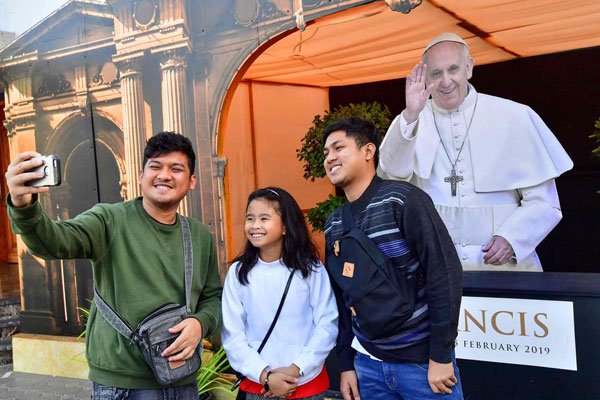Pope Francis’s three-day trip to the United Arab Emirates Sunday marks the first time a pontiff has ever visited the conservative Muslim Arabian Peninsula, where over 2.6 million Catholics reside.
While the overwhelming majority of Catholics in the region are expatriates, according to the Apostolic Vicariates of southern and northern Arabia, the pope’s journey to the birthplace of Islam is another milestone in his efforts to boost interreligious ties.
Kuwait was the first country in the region to formalise relations with the Vatican in 1968. Yemen followed suit in 1998, Bahrain in 2000, Qatar in 2002, and the United Arab Emirates in 2007.
Saudi Arabia and Oman have yet to establish formal diplomatic relations with the Holy See.
Last year, Saudi Arabia, home to Islam’s holiest sites in Mecca and Medina, hosted a flurry of representatives of various Christian traditions, as Crown Prince Mohammed bin Salman pushes for a more liberal kingdom.
In April 2018, Saudi Arabia hosted French Cardinal Jean-Louis Tauran, who headed the Vatican’s Pontifical Council for Interreligious Dialogue. Tauran, who died in July 2018, was seen as an energetic promoter of dialogue between the Catholic Church and Islam.
And in November 2017, the head of Lebanon’s Maronite church, Beshara Rai, paid an official visit to Saudi Arabia where he met King Salman and Prince Mohammed.
Overall, there are more than 3.5 million Christians in the Gulf, of which about 75 percent are Catholics, mostly migrant workers from the Philippines and India.
According to the Apostolic Vicariates, there are more than one million Catholics in Saudi Arabia alone, about 350,000 in Kuwait, 80,000 in Bahrain, and between 200,000 and 300,000 in Qatar, though no official figures exist.
Nearly one million Catholics live in the UAE, according to Bishop Paul Hinder of the Apostolic Vicariate of Southern Arabia, which encompasses the UAE, Oman and Yemen.
There are 22 Catholic churches in the region, where worshippers are welcome to visit and pray.
The UAE has the largest number of Catholic churches in the region with eight. Oman, Kuwait and Yemen each have four, while Qatar and Bahrain have one each.
Mass held in churches on Friday, which marks the first day of the weekend in the region, usually sees the biggest turnout.
In the UAE, mass is held at different timings during the week and in different languages — including English, Tagalog, Malayalam, and Urdu — to accommodate the different nationalities.
According to the Apostolic Vicariate of Northern Arabia — covering Bahrain, Kuwait, Qatar and Saudi Arabia — Catholics “enjoy freedom of worship within the confines of our parish compounds”.
Although in Saudi Arabia, all non-Muslim houses of prayer are banned.
The Apostolic Vicariate added that Catholics face some difficulties by the “restriction on the number of priests, too few churches and limited space in the churches”, especially during Christmas and Easter when mass attendance can reach up to 25,000.
“It is also forbidden (under threat of punishment) to engage in any public activity or display of religion, including proselytising (the act of attempting to convert people to Christianity),” says the Apostolic Vicariate of Northern Arabia.
While a majority of Christians in the region are migrant workers, there are a small number of local Christians in Kuwait, Bahrain and Yemen.
According to Father Emmanuel Benjamin Jacob Gharib, head of the National Evangelical Church of Kuwait, there are about 260 Kuwaiti Christians from eight extended families.
Unofficial estimates show there are 1,000 Christian Bahraini citizens and thousands of Christian Yemenis.
Source: AFP



